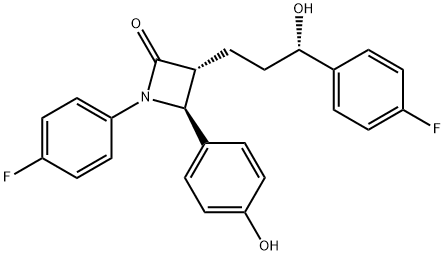| Description |
Ezetimibe is ananti-hyperlipidemic drug used for lowering the plasma cholesterol levels. It is indicated as an adjunctive therapy to diet for the reduction of high-level total-C, LDL-C, and ApoB in patients suffering primary (heterozygous familial and non-familial) hypercholesterolemia. It is also used in combination therapy with HMG-CoA reductase inhibitors.Ezetimibe does not inhibit the cholesterol synthesis in the liver, or increase bile acid excretion.It takes effect throughacting at the brush border of the small intestine and inhibiting the absorption of cholesterol, further leading to a decrease in the delivery of intestinal cholesterol to the liver. This causes a reduction of hepatic cholesterol stores and an increase in clearance of blood cholesterol. |
| Indications and Usage |
Ezetimibe is a new form of selective cholesterol absorption inhibitor developed in a collaboration between Schering-Plough Co. and Merck Co. This drug is the first cholesterol absorption selective inhibitor to be approved for sale by the American FDA. Its commercial name is Ezetrol.
This drug can be used alone or in combination with HMG-CoA reductase inhibitors (statins) to treat primary (heterozygous familial and non-familial) hypercholesterolemia, homozygous familial hypercholesterolemia (HoFH), homozygous viremia (or phytosterolemia). |
| Mechanisms of Action |
Ezetimibe’s mechanisms of action are different from those of other lipid-lowering drugs (such as statins, cholic acid chelating agents, phenoxy acid derivatives, and plant sterols). This drug binds with the surface proteins on the brush border membrane vesicles of the small intestine (relative molecular mass 145x10^3) to inhibit the small intestine’s absorption of cholesterol in food and bile, thus decreasing the cholesterol content in serum and the liver. Ezetimibe is different from bile acid sequestrants because it does not affect the absorption of cholesterol esters, other steroids (such as bezoar and cholic acid), three triacylglycerol, and fat-soluble vitamins. Its effects are unrelated to whether or not acetyl coenzyme A- cholesterol acetyltransferase (ACAT) is inhibited or whether or not the LDL receptor (scavenger receptor) is expressed. After Ezetimibe is absorbed and binds with glucuronic acid in the liver, it undergoes enterohepatic circulation and almost exclusively targets small intestine mucosa cells. |
| References |
https://en.wikipedia.org/wiki/Ezetimibe
https://pubchem.ncbi.nlm.nih.gov/compound/Ezetimibe#section=Top
https://www.drugbank.ca/drugs/DB00973
Davidson, Michael H, et al. "Ezetimibe coadministered with simvastatin in patients with primary hypercholesterolemia ☆." Journal of the American College of Cardiology 40.12(2002):2125.
Sudhop, T, et al. "Inhibition of intestinal cholesterol absorption by ezetimibe in humans. " Circulation 106.15(2002):1943-8. |
| Chemical Properties |
White Solid |
| Uses |
An antihyperlipoproteinemic. A Cholesterol absorption inhibitor |
| Uses |
antibacterial |
| Uses |
A cholesterol transport inhibitor that binds to NPC1L1 |
| Uses |
For use as adjunctive therapy to diet for the reduction of elevated total-C, LDL-C, and Apo B in patients with primary (heterozygous familial and non-familial) hypercholesterolemia. |

 China
China






